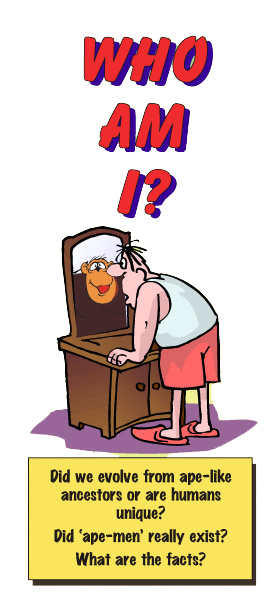
FOOLING THE 'EXPERTS'
Ever since Charles Darwin's day, evolutionists have been trying to find fossils to prove that we evolved from ape-like ancestors. In the process they have often fooled themselves and the general public.
When scientists discovered some jaws and teeth in North India in 1910, they confidently claimed they belonged to a 'hominid' which was an early ancestor of humans. They named it Ramapithecus, and pictured it a stooping, hairy creature, despite the meagre evidence. Later, more extensive fossil remains were uncovered, and it was admitted that Ramapithecus was related to orang-utans not humans!

 The most famous mistake — actually a hoax — was the case of Piltdown Man. In 1912 part of a skull and jawbone were unearthed in a gravel-pit at the English village of Piltdown. The skull was human-like but the jaw ape-like, so it was hailed as 'proof' of evolution — a real English 'ape-man'! It was not until 1953 that it was discovered that an unknown hoaxer had planted a human skull fragment and ape's jaw after filing the teeth and colouring the bones to make them look old, fooling experts and public for 41 years!
The most famous mistake — actually a hoax — was the case of Piltdown Man. In 1912 part of a skull and jawbone were unearthed in a gravel-pit at the English village of Piltdown. The skull was human-like but the jaw ape-like, so it was hailed as 'proof' of evolution — a real English 'ape-man'! It was not until 1953 that it was discovered that an unknown hoaxer had planted a human skull fragment and ape's jaw after filing the teeth and colouring the bones to make them look old, fooling experts and public for 41 years!
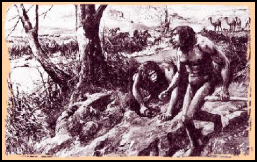
The picture above was a double-page spread in the Illustrated London News (22nd, June 1922). It depicted a supposed ancestor of ours — Nebraska Man. This picture was based on a single tooth which scientists claimed had the characteristics of both apes and humans, so must have belonged to an 'ape-man'. Not long afterwards it was discovered that the tooth had belonged to a peccary — an extinct type of wild pig!
When you read about the discovery of fossils of our supposed ape-like ancestors, or see reconstructions of them, do you stop to ask what evidence they are based on? You may be surprised; often it's just a few pieces of bone, plus lots of imagination. Yet exaggerated claims are sometimes made, based on very meagre evidence. It's always wise to ask “What has actually been found?”
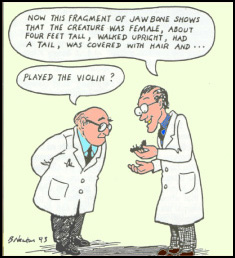
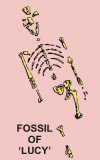
 Evolutionists claim that the Australopithecines, represented by a number of fossil remains, were our ape-like ancestors. One of the most famous is 'Lucy', discovered by Dr Donald Johanson in 1974. However, these creatures were very similar to living bonobo chimps, which often walk bi-pedally. Australopithecine means 'southern ape', and we believe this is an apt description. There is no convincing evidence that they are part of our family tree.
Evolutionists claim that the Australopithecines, represented by a number of fossil remains, were our ape-like ancestors. One of the most famous is 'Lucy', discovered by Dr Donald Johanson in 1974. However, these creatures were very similar to living bonobo chimps, which often walk bi-pedally. Australopithecine means 'southern ape', and we believe this is an apt description. There is no convincing evidence that they are part of our family tree.
Part of the Human Family
Neanderthal Man was once depicted as a brutish 'ape-man', but researchers now agree that this species was fully human. Neanderthals had larger brains than modern humans, could speak, used tools, played music and had a religion. Homo erectus, which had a brain size well within the modern range, is also now regarded as being fully human. Dressed in modern clothes, both the Neanderthal and Homo erectus people would attract little if any attention in a busy street. In fact, evidence shows that both were living with modern-type humans, so they couldn't be our ancestors.

 The popular view of the Neanderthals as brutish 'ape-men' (left) was mistaken. The reconstruction on the right is much more accurate.
The popular view of the Neanderthals as brutish 'ape-men' (left) was mistaken. The reconstruction on the right is much more accurate.
'MISSING LINK' WAS JUST A GORILLA!

 In July 2002 the media gave headline treatment to the discovery of a new 'ape-man' — nicknamed the Toumai skull — in the Sahara desert (right). Its discoverer, French scientist Michel Brunet claimed it was a '7-million year-old' ancestor of ours, with 'a close relationship to the last common ancestor between humans and chimpanzees.' However, within 24 hours, most scientists dismissed these claims, saying that Toumai was nothing more than a female gorilla! The media did not report the fact that Toumai wasn't an 'ape-man' after all.
In July 2002 the media gave headline treatment to the discovery of a new 'ape-man' — nicknamed the Toumai skull — in the Sahara desert (right). Its discoverer, French scientist Michel Brunet claimed it was a '7-million year-old' ancestor of ours, with 'a close relationship to the last common ancestor between humans and chimpanzees.' However, within 24 hours, most scientists dismissed these claims, saying that Toumai was nothing more than a female gorilla! The media did not report the fact that Toumai wasn't an 'ape-man' after all.

Even though the fossil evidence doesn't reveal any relationship between ourselves and apes, surely they resemble us so much that there has to be a connection? Agreed, apes and humans do appear to have similarities, and some apes are quite intelligent, but the differences are much greater than the similarities, differences which fossils can never reveal.
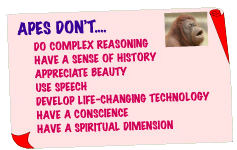
Apes have no sense of right and wrong, they don't ponder the purpose of life, or fret over world problems. They don't compose music, admire sunsets, or gaze in wonder at the stars. Apes can be taught a simple sign language, but they can't speak, since they lack the special muscles in the throat and mouth. There is no evidence that human language evolved from animal noises — the oldest human languages are more complex than modern ones. Apes aren't religious; they don't pray, worship, or bury their dead. Yet every human tribe so far discovered possesses some kind of religious belief. This reveals that humans, unlike animals, have a spiritual dimension, and supports the Biblical view that we were created by God to have a relationship with Him.
There is a great gulf between apes and ourselves!

Facing Facts
Even some evolutionary scientists admit that there are problems with the theory of human evolution.
'It is very likely that no fossil hominid yet found is on the direct line of descent to modern humans.' — J.Jones1
'... in the present state of our knowledge, I do not believe it is possible to fit the known hominid fossils into a reliable pattern.' — Dr. Mary Leakey.2
A growing body of scientists go much further and claim that the fossil evidence actually supports the Biblical view of human origins.
'The Bible, the Word of the living God, clearly declares that humans were specially created. The human fossil evidence is completely in accord with what the Scriptures teach.' — Dr. Marvin Lubenow. 3
'There is thus no evidence, either in the present world or in the world of the past, that man has arisen from some 'lower' creature. He stands alone as a separate and distinct basic type.' — Dr. Duane Gish.4
And what is 'the Biblical View'? 'God created man in his own image, in the image of God he created him; male and female he created them.' (Genesis 1:27). However, the Bible not only tells us about our origins, but also our destiny. It tells the sad story of human rebellion against the Creator, and how God stepped into history to save us from the consequences of our own folly. 'God so loved the world that he gave his one and only Son, that whoever believes in him shall not perish but have eternal life.' (John 3:16).
Besides having no factual basis, evolution is a hopeless creed, offering no purpose in life or hope beyond the grave. But those who come to God through Jesus Christ find forgiveness, purpose in living and hope in dying. God loves you, and longs for you to know Him. Want to know more? Contact the publisher or distributor of this leaflet.
1. Nature, Vol 345 (May 31st 1990), pp. 395-396.
2. Disclosing the Past, (Doubleday, 1984), p. 214.
3. Bones of Contention, (Baker Books, 1992), p. 183.
4. Evolution: the Fossils still say No! (Institute for Creation Research, 1995), p. 331.


